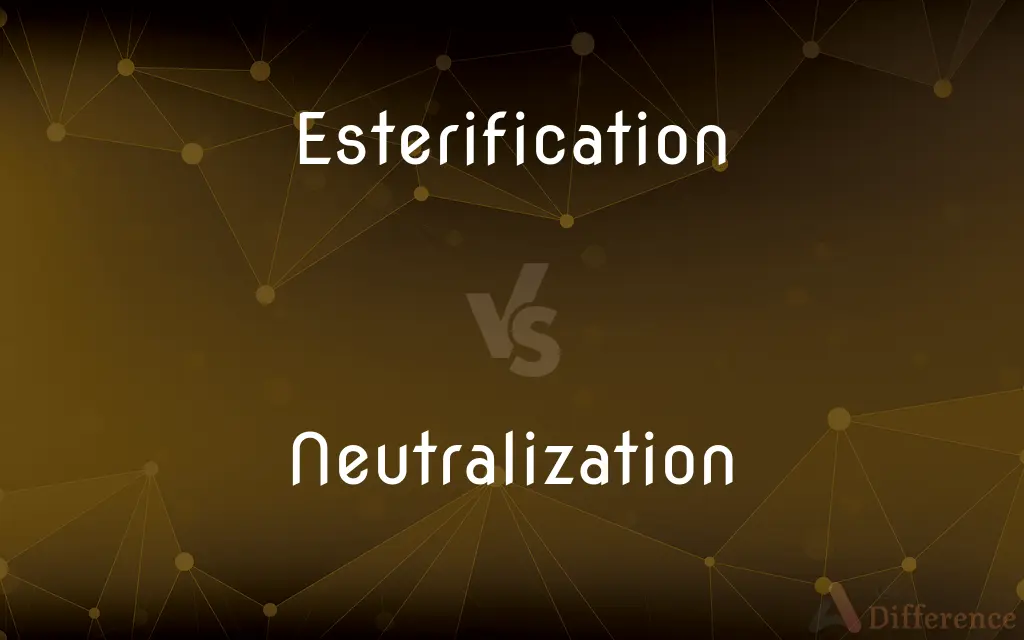Esterification vs. Neutralization — What's the Difference?
By Maham Liaqat & Urooj Arif — Updated on March 13, 2024
Esterification is a chemical reaction forming esters from acids and alcohols, while neutralization involves acid-base reactions to form salt and water.

Difference Between Esterification and Neutralization
Table of Contents
ADVERTISEMENT
Key Differences
Esterification is a key reaction in organic chemistry where carboxylic acids react with alcohols, catalyzed by an acid, to produce esters and water. This process is essential for synthesizing fragrances, flavors, and plastics. On the other hand, neutralization is a fundamental reaction in both organic and inorganic chemistry, where acids and bases react to form salt and water, often releasing heat. This reaction is crucial in various applications, including titration in analytical chemistry, wastewater treatment, and the manufacturing of various household products.
In esterification, the choice of acid and alcohol, along with the specific catalyst, determines the type of ester produced, impacting its smell, boiling point, and solubility. This selectivity allows chemists to design esters with specific properties for use in perfumes, plastics, and solvents. Whereas, in neutralization, the properties of the resulting salt, such as solubility and crystalline structure, are influenced by the specific acid and base used. This makes neutralization important in producing a wide range of salts for food, industrial, and pharmaceutical purposes.
Esterification reactions are reversible, where esters can hydrolyze back into the original acid and alcohol under certain conditions, making the reaction equilibrium important in industrial applications. This reversibility is exploited in processes like saponification for soap making. In contrast, neutralization reactions are generally considered to go to completion, especially in aqueous solutions, making them ideal for titrations and quantitative analysis in laboratories.
The kinetics of esterification can be slow and require a catalyst, such as sulfuric acid, to proceed at a practical rate. Temperature and concentration of reactants also significantly affect the rate of esterification. Neutralization reactions, however, tend to be fast and exothermic, often proceeding quickly to completion without the need for a catalyst, although the pH of the environment can affect the reaction rate.
Esterification is crucial in the synthesis of biodiesel, where triglycerides (fats/oils) react with methanol to produce fatty acid methyl esters (FAME) and glycerol, a renewable energy source. Conversely, neutralization plays a key role in environmental engineering, such as treating acid mine drainage with alkaline substances to neutralize acidity and protect aquatic life.
ADVERTISEMENT
Comparison Chart
Reaction Type
Organic, synthesizing esters
Acid-base, forming salt and water
Reactants
Carboxylic acid and alcohol
Acid and base
Products
Ester and water
Salt and water
Industrial Use
Fragrances, flavors, plastics
Wastewater treatment, food, pharmaceuticals
Reaction Conditions
Requires catalyst, reversible
Often exothermic, goes to completion
Compare with Definitions
Esterification
Esterification involves forming an ester by reacting a carboxylic acid with an alcohol.
Acetic acid and ethanol react to form ethyl acetate and water.
Neutralization
Neutralization involves an acid and a base reacting to form salt and water.
Hydrochloric acid and sodium hydroxide react to form sodium chloride and water.
Esterification
The reaction rate can be affected by temperature, catalyst, and the concentrations of reactants.
Increasing the concentration of acetic acid can speed up the formation of ethyl acetate.
Neutralization
Used in wastewater treatment, medicine, and cooking.
Neutralization is used in antacids to neutralize stomach acid.
Esterification
Used in the synthesis of flavors, fragrances, and plastics.
Esterification is used to produce isopentyl acetate, a banana-flavored ester.
Neutralization
Proceeds rapidly, often without the need for a catalyst.
Adding vinegar to baking soda (sodium bicarbonate) rapidly produces carbon dioxide and water.
Esterification
Often requires an acid catalyst to proceed efficiently.
Sulfuric acid is used to catalyze the reaction between acetic acid and ethanol.
Neutralization
The reaction is exothermic, releasing heat.
Mixing hydrochloric acid with sodium hydroxide releases heat.
Esterification
The reaction is reversible, allowing esters to be hydrolyzed back into acids and alcohols.
Ethyl acetate can be hydrolyzed back to acetic acid and ethanol in the presence of water.
Neutralization
Reactions typically go to completion, especially in aqueous solutions.
Neutralization of sulfuric acid with sodium hydroxide completely forms sodium sulfate and water.
Esterification
A chemical reaction resulting in the formation of at least one ester product.
Neutralization
A chemical reaction in which an acid and a base interact with the formation of a salt; with strong acids and bases the essential reaction is the combination of hydrogen ions with hydroxyl ions to form water
Esterification
(organic chemistry) Any reaction (typically between an acid and an alcohol) that results in the production of an ester
[http://www.sigmaaldrich.com/etc/medialib/docs/Aldrich/Acta/al_acta_30_01.pdf Aldrichimica Acta Volume 30 No 4] (pdf) from [http://www.sigmaaldrich.com/chemistry/chemical-synthesis/learning-center/aldrichimica-acta.html Sigma-Aldrich]
Neutralization
Action intended to keep a country politically neutral or exclude it from a possible war;
The neutralization of Belgium
Neutralization
The act or process of neutralizing.
Neutralization
The state or quality of being neutralized.
Neutralization
(Chemistry) A reaction between an acid and a base, usually yielding a salt and water.
Neutralization
The act of neutralizing.
Neutralization
The act or process of neutralizing, or the state of being neutralized.
Neutralization
Action intended to nullify the effects of some previous action
Common Curiosities
Can esterification reactions be reversed?
Yes, esterification reactions are reversible, allowing the esters to be hydrolyzed back into the original acid and alcohol.
Do both esterification and neutralization require catalysts?
Esterification often requires a catalyst to proceed efficiently, while neutralization does not typically require a catalyst.
What role does temperature play in esterification reactions?
Temperature can significantly affect the rate of esterification, with higher temperatures generally increasing the reaction rate.
Are neutralization reactions exothermic or endothermic?
Neutralization reactions are exothermic, releasing heat as they proceed.
What is neutralization?
Neutralization is a reaction between an acid and a base to produce salt and water, typically releasing heat.
What is a common use of neutralization reactions?
Neutralization is commonly used in wastewater treatment to adjust pH levels and in medicine to create antacids.
How are the products of esterification and neutralization different?
Esterification produces esters and water, whereas neutralization results in the formation of salt and water.
What is the significance of catalysts in esterification?
Catalysts lower the activation energy, making the esterification process faster and more efficient.
What is an example of a salt formed through neutralization?
Sodium chloride is a common salt formed by neutralizing hydrochloric acid with sodium hydroxide.
What is esterification?
Esterification is a chemical reaction where a carboxylic acid reacts with an alcohol to form an ester and water.
How do esterification and neutralization differ in terms of reactants?
Esterification uses carboxyl acids and alcohols as reactants, while neutralization involves acids and bases.
Can neutralization be used in environmental protection?
Yes, neutralization can treat acidic waste streams, protecting water bodies from acidification.
How do esterification reactions contribute to industry?
They are pivotal in producing synthetic fragrances, flavors, and plastics.
Share Your Discovery

Previous Comparison
Conceptualization vs. Operationalization
Next Comparison
Cultivator vs. PloughAuthor Spotlight
Written by
Maham LiaqatCo-written by
Urooj ArifUrooj is a skilled content writer at Ask Difference, known for her exceptional ability to simplify complex topics into engaging and informative content. With a passion for research and a flair for clear, concise writing, she consistently delivers articles that resonate with our diverse audience.













































